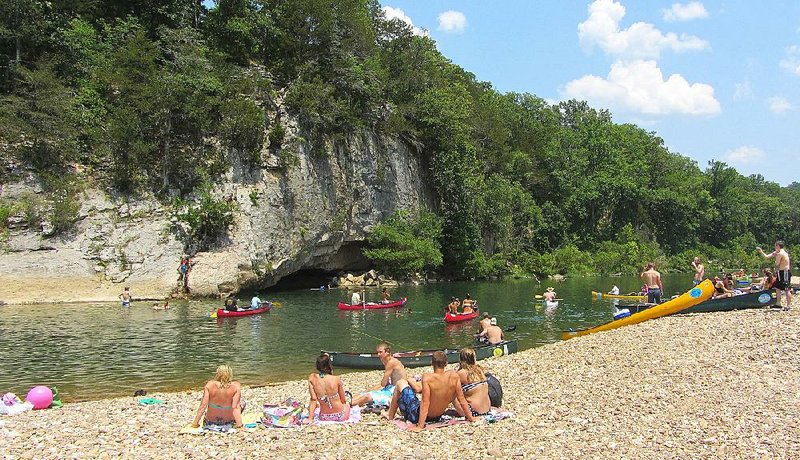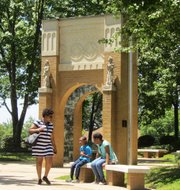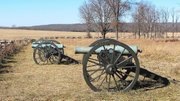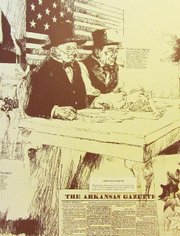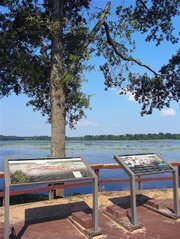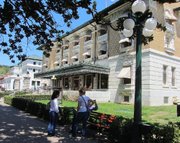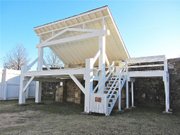As the National Park Service celebrates its centennial this year, Arkansas can plausibly claim to have the oldest U.S. national park. That's true once you buy into the notion that a national park by any other name is still a national park.
The Park Service, which operates 411 locations across the United States, was established in 1916. Natural State residents can point out with pride that the site now called Hot Springs National Park dates all the way to 1832.
The distinction is one of nomenclature. When President Andrew Jackson's signature set aside Hot Springs 184 years ago, it was called a national reservation (in the sense that it was reserved for federal use).
It took another 40 years before Yellowstone was designated as America's first national park. Once Congress had created the Park Service a century ago, the Hot Springs facility gained its more distinguished name in 1921.
Hot Springs is Arkansas' only full-fledged national park. But the six other National Park Service units in our state speak to a rich variety of natural and man-made attractions. Sadly, several also attest to conflict and violence in the past. In alphabetical order, the seven are:
• Arkansas Post National Memorial: Founded by French explorer Henri de Tonti in 1686, Arkansas Post was the future state's first permanent European settlement.
In Colonial times, the fur trade operated briskly at this tiny Arkansas River town, about 100 miles southeast of Little Rock. Spain took over in 1763, then the French again in 1800, then the young United States in 1804 via the Louisiana Purchase.
As exhibits and a 20-minute film explain at the memorial's visitor center, U.S. sovereignty brought enough prominence that Arkansas Post became the first capital of Arkansas Territory in 1819. The same year, the Arkansas Gazette began printing here as the first newspaper west of the Mississippi River.
After the territorial capital was moved to Little Rock in 1821, Arkansas Post dwindled into obscurity. When the Civil War broke out, the Confederacy built Fort Hindman to guard the river passage. Vastly superior Union forces captured the fort in January 1863, after which the town site was razed.
That leaves a visitor's imagination free to roam while walking two marked trails through the long-ago community. One landmark is a replica of the Roman Catholic cross erected by de Tonti more than three centuries ago, evoking the seminal role of Arkansas Post in our early history.
• Buffalo National River: It took a citizens' campaign led by the Ozark Society's Neil Compton to prevent the Buffalo River from being dammed as so many other waterways in Arkansas and elsewhere had been.
Instead, the U.S. Congress voted in 1972 to establish the Buffalo as America's first national river, which snakes its way for 135 miles through Newton, Searcy, Marion and Baxter counties. One of the few unpolluted and free-flowing rivers in the Lower 48 states, it brings recreational pleasure to hundreds of thousands of visitors each year.
Descending from the Ozark Mountains to the White River, the river offers numerous launch points for float trips by canoeists and kayakers, who can enjoy a variety of water conditions from swirling rapids to pondlike eddies. There are swimming holes as well.
Attractions ashore include more than 100 miles of hiking trails, as well as designated routes for horseback riding. The park's topography includes Fitton Cave, the state's longest known cavern. Among the river's four designated historic areas are Rush Mining District, now a tumble-down ghost town, and scenic Boxley Valley.
Ozarks troubadour Jimmy Driftwood summed up the priceless value of Buffalo National River as "Arkansas' gift to the nation, America's gift to the world."
• Fort Smith National Historic Site: Fort Smith ranked as a frontier town in the decades after the Civil War. It was the last westward stop before entering the mostly untamed Indian Territory of Oklahoma.
That rough-and-tumble era is portrayed at Fort Smith National Historic Site, where the most striking artifact is a replica of the wooden gallows where as many as six miscreants at a time were hanged. Under the jurisdiction of Judge Isaac C. Parker, 86 felons were executed over a 23-year period.
Parker was known as a "hanging judge." The National Park Service brochure asserts that the reputation "is understandable, but unfair. He made the court system honest and tried to rehabilitate prisoners, but giving Indian Territory law and order was tough." Statistically, Parker tried 344 cases of murder or rape, both of which required the federal death penalty. Only one-quarter of those perpetrators were actually put to death.
The site's visitor center is in the basement of the 1888 "Hell-on-the-Border" U.S. jail. Parker's courtroom has been reconstructed upstairs. The massive stone Commissary Building offers an audio program conveying the hustle and bustle of the era's daily Army life.
• Hot Springs National Park: Bathhouse Row, the heart of Hot Springs National Park, is looking spruce these days after rejuvenation during the past two decades. Six of the eight vintage bathhouses along Central Avenue are now open to the public in one way or another.
The best place to start is the Fordyce Bathhouse, which houses the national park's visitor center. Its 23 restored rooms display and explain the array of aquatic treatments from the Garland County city's health-resort heyday in the first half of the 20th century.
Two other bathhouses, the Buckstaff and the Quapaw, provide hot baths and other spa treatments at a variety of prices. The Superior houses a craft brewery and purveys its beverages along with food. The Ozark, now known as the Ozark Bathhouse Cultural Center, is used for park programs and available for rental for private events. It was home to the Museum of Contemporary Art of Hot Springs until it closed in 2013. The Lamar contains the park's amply stocked gift shop.
A tour of the Fordyce reveals the opulence that awaited well-off bathers in the 1920s and '30s. The men's bath hall on the first floor dazzles with a domed skylight created from 8,000 pieces of colored glass. The hall's centerpiece is an ornate fountain depicting the explorer Hernando de Soto and an American Indian maiden.
• Little Rock Central High School National Historic Site: Fifty-nine years ago, Arkansas' reputation was sorely stained by the desegregation crisis at Central High. Film clips and newspaper photos showed the world the nine newly admitted black students bravely facing threats and racial slurs from angry mobs of protesting whites.
Some of those distressing images are displayed at Little Rock Central High School National Historic Site, just northeast of the high school itself. A television monitor replays a telling interview by Mike Wallace with Gov. Orval Faubus, chief symbol of the anti-integration forces.
Exhibits make clear the importance of women in the crisis, starting with Daisy L. Gatson Bates, whose mentoring of the black students led to shots being fired at her home and the firebombing of her lawn. The role of the Women's Emergency Committee in dauntlessly working to get Little Rock's public high schools reopened in 1959 is mapped out.
Across Park Street from the visitor center, the Central High Commemorative Garden invites contemplation. Reflective arches echo the school's facade, while nine trees and benches honor the black students.
• Pea Ridge National Military Park: Ranked as one of the best preserved Civil War battlefields, Pea Ridge National Military Park saw bloody fighting on March 7-8, 1862. It has been called, with a dash of hyperbole, "the Gettysburg of the West."
The 4,300 acres of Pea Ridge's battlefield largely preserve the rolling fields and woods where a decisive Northern victory played a key role in keeping Missouri in the Union. It also opened Arkansas to later occupation by the North. The two days' casualties totaled about 3,400 dead and wounded.
An enlightening 28-minute film maps out the battle and its importance. Displays put a human face on the combat. One posted quotation from Confederate Pvt. Asa Payne pinpoints the feelings of bravado and fear: "I remember some of our boys would laugh and mock the shells, and others were as pale as death, while still others had great drops of sweat on their faces. Here was a place that tried men's souls."
The battlefield can be toured on a seven-mile road marked by National Park Service signs. The best view comes at Stop No. 7, where a 150-yard path leads to a shelter overlooking fields where so much blood was shed.
• President William Jefferson Clinton Birthplace Home National Historic Site: Work is proceeding on the two-story Clinton Birthplace Home in Hope to repair damage from a Dec. 25 fire believed to have been arson.
It is possible that the historic residence will be reopened to the public before the end of summer. Meanwhile, the visitor center remains open, featuring interpretive exhibits about the early years of the future 42nd U.S. president.
When the house itself is back in business, visitors can see memorabilia including a trophy little Billy won in a local cutest baby contest. The half-dozen playing cards tacked to the kitchen window are like those pasted there by his grandmother to help him learn how to count.
Upstairs, the 8-by-10-foot cubbyhole where the youngster slept is fitted out with a crib. It's like the one from which Clinton recalled in his memoirs having listened to trains rumbling past and wondering "where they were going and whether I would ever go there."
Style on 05/22/2016
